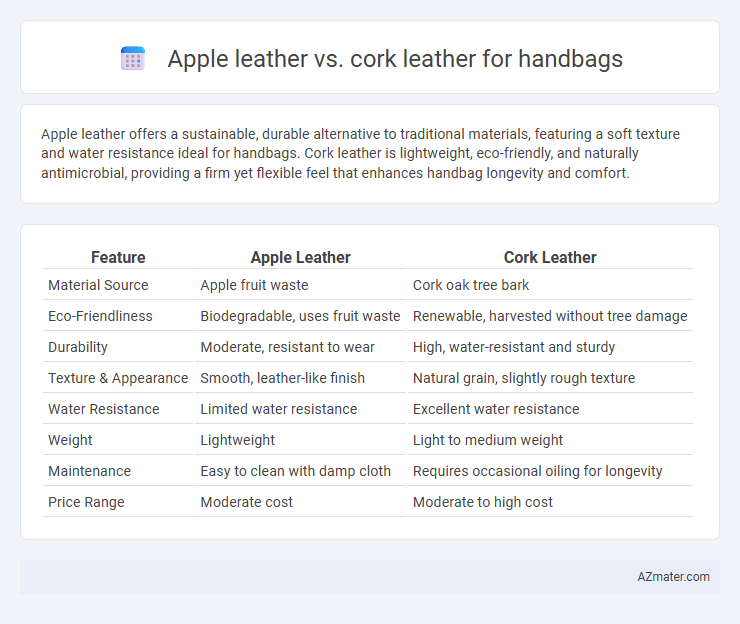Apple leather offers a sustainable, durable alternative to traditional materials, featuring a soft texture and water resistance ideal for handbags. Cork leather is lightweight, eco-friendly, and naturally antimicrobial, providing a firm yet flexible feel that enhances handbag longevity and comfort.
Table of Comparison
| Feature | Apple Leather | Cork Leather |
|---|---|---|
| Material Source | Apple fruit waste | Cork oak tree bark |
| Eco-Friendliness | Biodegradable, uses fruit waste | Renewable, harvested without tree damage |
| Durability | Moderate, resistant to wear | High, water-resistant and sturdy |
| Texture & Appearance | Smooth, leather-like finish | Natural grain, slightly rough texture |
| Water Resistance | Limited water resistance | Excellent water resistance |
| Weight | Lightweight | Light to medium weight |
| Maintenance | Easy to clean with damp cloth | Requires occasional oiling for longevity |
| Price Range | Moderate cost | Moderate to high cost |
Introduction: The Rise of Plant-Based Leathers
Plant-based leathers, such as Apple leather and Cork leather, have gained significant popularity due to their eco-friendly properties and sustainable sourcing. Apple leather is derived from apple pomace, a byproduct of juice production, offering a soft texture and durability, while Cork leather is harvested from the bark of cork oak trees, known for its natural waterproof and lightweight characteristics. Both materials provide cruelty-free, biodegradable alternatives to traditional animal leather, appealing to environmentally conscious consumers in the handbag market.
What is Apple Leather?
Apple leather is an innovative sustainable material made from apple waste, specifically the leftover peels and cores from juice production, processed into a durable, eco-friendly alternative to traditional leather. It offers a soft texture, breathability, and water resistance, making it ideal for handbags while reducing environmental impact compared to animal leather. Cork leather, on the other hand, is derived from the bark of cork oak trees, featuring lightweight, water-resistant, and vegan properties, yet apple leather stands out for its innovative upcycling of fruit waste.
What is Cork Leather?
Cork leather, derived from the bark of cork oak trees, is a sustainable and eco-friendly material known for its lightweight, water-resistant, and durable properties, making it ideal for handbags. Unlike traditional leather and plant-based alternatives like apple leather, cork leather offers natural antimicrobial qualities and a unique textured appearance that enhances handbag aesthetics and longevity. Its renewable harvesting process contributes to environmental conservation, appealing to consumers seeking ethical fashion choices.
Durability: How Do They Compare?
Apple leather offers moderate durability with a smooth finish that withstands everyday use but may show wear over time, especially in high-friction areas. Cork leather excels in durability due to its natural resilience and water-resistant properties, making it highly resistant to scratches and cracks while maintaining flexibility. Both materials provide sustainable alternatives to traditional leather, but cork leather typically outperforms apple leather in long-term durability for handbags.
Sustainability and Environmental Impact
Apple leather, crafted from upcycled apple waste, offers a biodegradable and resource-efficient alternative to traditional leather, significantly reducing waste and water consumption during production. Cork leather, harvested from the renewable bark of cork oak trees without harming the tree, supports biodiversity, promotes carbon sequestration, and ensures minimal ecological disruption. Both materials are vegan, chemical-free, and contribute to lowering the fashion industry's carbon footprint by replacing animal leather with sustainable, plant-based options.
Aesthetic and Design Versatility
Apple leather offers a smooth, consistent texture that mimics traditional leather, enhancing sleek and modern handbag designs. Cork leather provides a natural, irregular grain with earthy tones, lending an organic and unique aesthetic ideal for eco-conscious fashion. Both materials support diverse design versatility, but apple leather excels in polished, refined styles, while cork leather suits rustic, artisanal looks.
Comfort and Texture Differences
Apple leather offers a smooth, supple texture with a soft, flexible feel that enhances comfort during prolonged use. Cork leather provides a unique, slightly textured surface with natural breathability, making it lightweight and comfortable for everyday wear. Both materials are eco-friendly alternatives to traditional leather, but apple leather tends to feel more akin to genuine leather, while cork leather has a distinct, organic tactile quality.
Maintenance and Care Tips
Apple leather requires gentle cleaning with a damp cloth and mild soap to maintain its smooth texture, while avoiding excessive water to prevent damage. Cork leather benefits from regular wiping with a soft cloth and occasional conditioning with natural oils to retain its flexibility and water resistance. Both materials should be kept away from direct sunlight and heat sources to prevent fading and cracking, ensuring long-lasting durability for handbags.
Cost Comparison
Apple leather handbags typically have a higher price point than cork leather due to the more complex production process involving apple waste and polyurethane coatings, which drives up manufacturing costs. Cork leather, derived from the bark of cork oak trees, offers a cost-effective and sustainable alternative with lower raw material and processing expenses, resulting in more affordable handbags. Consumers prioritizing budget without sacrificing eco-friendliness often find cork leather handbags to provide better value compared to premium-priced apple leather options.
Which is Best for Handbags?
Apple leather offers durability, a smooth texture, and eco-friendly production from apple waste, making it suitable for premium handbags requiring a vegan alternative to traditional leather. Cork leather, harvested from cork oak bark, is lightweight, water-resistant, and naturally antimicrobial, ideal for handbags demanding a unique, sustainable, and hypoallergenic material. Choosing the best depends on your preference between the sleek finish and firmness of apple leather versus the flexible, breathable qualities and distinctive appearance of cork leather.

Infographic: Apple leather vs Cork leather for Handbag
 azmater.com
azmater.com